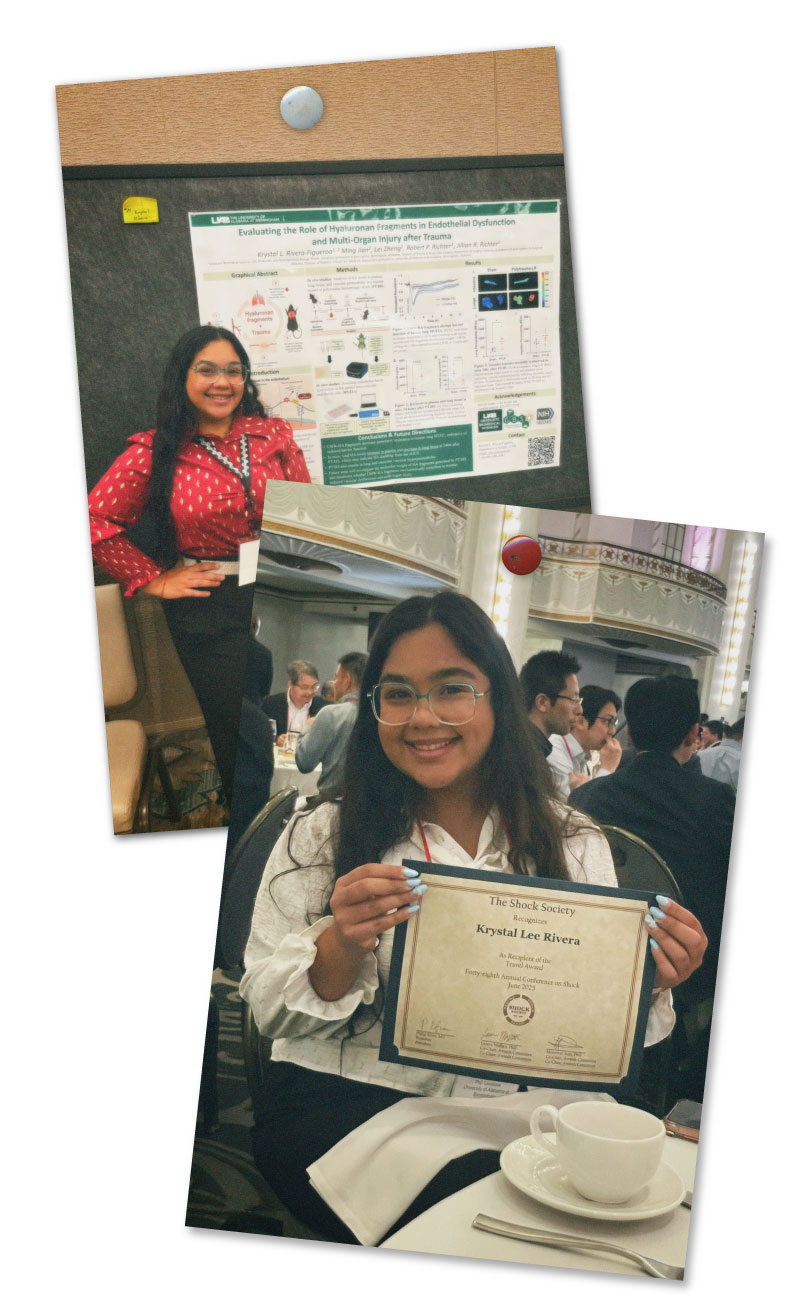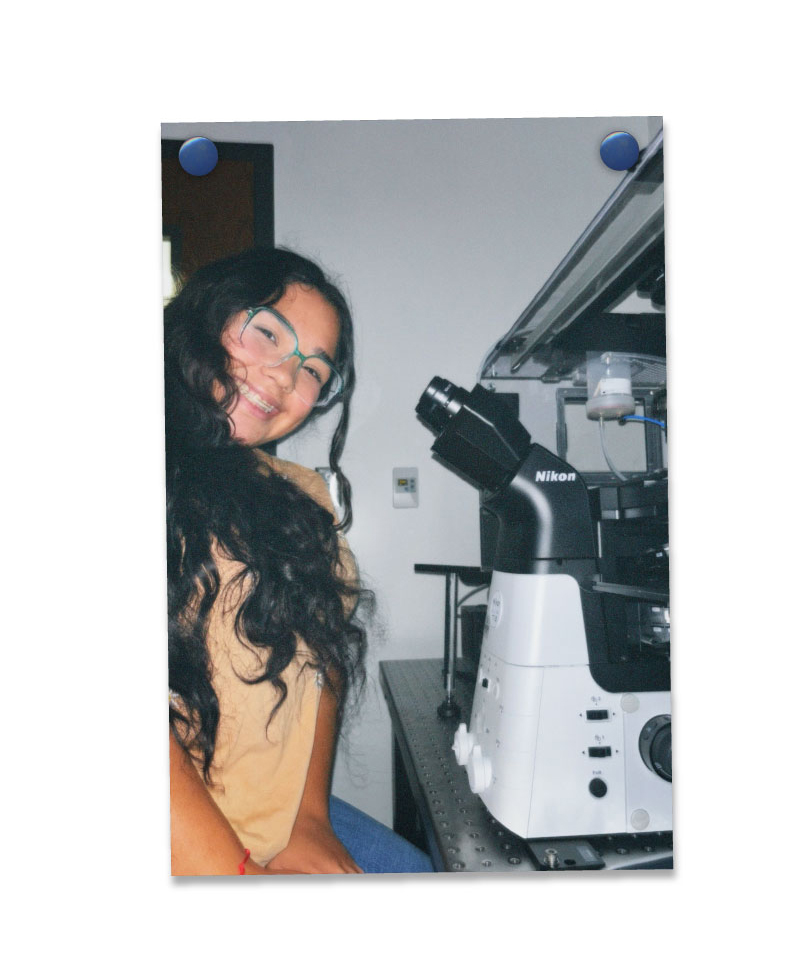
I arrived in Birmingham with a suitcase, a dream, and more self-doubt than I cared to admit. As a Puerto Rican woman in STEM (science, technology, engineering, and mathematics), I came to UAB in 2023 to pursue a Ph.D. in biomedical science. I felt excited, determined, and a little bit afraid. After rotating in a few different laboratories, I chose to work in the UAB Division of Trauma and Acute Care Surgery within the Department of Surgery. Drawing on my undergraduate degree in cardiopulmonary sciences, I realized that studying traumatic injury offered a unique opportunity to bridge my academic background with real-world impact. This path enables me to apply my expertise to directly support patients in crisis and make a meaningful contribution to society.
In this role, I investigate the biological effects of traumatic injury. Specifically, I study how trauma disrupts the vascular system, the network of blood vessels that delivers oxygen and nutrients to our organs. One of the molecules I study is hyaluronic acid, a sugar-like molecule naturally found in our bodies. After traumatic injury, this molecule can send signals to the immune system, either helping the body heal or worsening inflammation. My project seeks to improve our understanding of how hyaluronic acid behaves after trauma. In enhancing our understanding of hyaluronic acid, I hope to uncover new ways to help patients recover and protect the vascular system that keeps us alive.
Traumatic injury is the number one cause of death for Americans under 45. It is sudden, devastating, and often triggers a cascade of vascular damage that contributes to long-term complications or death from severe blood loss. In those critical moments after injury, survival can depend on what happens to the blood vessels of the vascular system. My research project focuses on understanding how trauma damages the vascular endothelium and how we might develop a therapeutic agent to protect it during those early, crucial hours. I came to UAB to understand trauma on a molecular level. What I did not expect was how deeply I would also learn about recovery, resilience, and healing both in the lab and in myself.
The Science of Healing
Trauma does not end when the bleeding stops. In the lab, I study how the vascular endothelium, defined as the inner lining of our blood vessels, begins to unravel after severe traumatic injury. Hyaluronic acid, normally a quiet protector in the body, helps tissues stay hydrated and strong. But after trauma, it can break down into fragments that make everything worse: more inflammation, more leakage, more damage.
Through plasma samples from trauma patients and experiments with human endothelial cells and mouse models, I try to map what goes wrong at the molecular level and how we might intervene. Can we block the signals that trigger more harm? Can we protect the fragile blood vessels that hold everything together? These are the scientific questions I chase. But in chasing them, I started asking myself other questions, too: What helps a person hold themselves together after life breaks them open? What allows healing to begin?
My mornings start early. I am often in the lab before the city fully wakes up, pipetting quietly while the sun begins to rise over Birmingham’s skyline. Some days, I process fresh plasma from trauma patients, including blood donated just hours after a crash, a fall, or a near-fatal rupture. These are not just tubes of blood; they are pieces of a person’s fight to survive. Other mornings, I work with our animal models by assisting with surgeries that model trauma and hemorrhagic shock or collecting tissue samples to study how injury changes the body at the molecular level. Between the patient samples, the animal models, and the cells I culture, my mornings move between the sharp urgency of trauma and the delicate precision of research.
In the afternoons, I trade my pipette for the microscope. I spend hours peering into the cellular world, looking for signs of damage or healing that might be invisible to the naked eye. The endothelial cells I work with are delicate and complex, just like the patients they represent. I stain, image, and analyze, searching for patterns in how trauma disrupts the very structure of life. These images, these shifts in cell shape or barrier integrity, are where I begin to understand what the body endures and what it needs to recover.
Not every day is a triumph. Sometimes my cells die. Sometimes my data contradicts what I hoped to find. Some days, I cry at my desk because I miss home or because I feel like I am failing. Then I wipe my face, tie my hair back, and go back in. Because this is more than science. It’s my calling. And it’s also my own story.
 The Path to UAB
The Path to UAB
It means so much to me to be part of a top-tier research institution that believes in the work I do. At UAB, I’m surrounded by brilliant minds, supported by mentors who challenge and guide me and have given me the tools to pursue questions that matter.
My journey here began long before UAB. I grew up in Puerto Rico, where I saw firsthand the gaps in health care and the limited access to advanced medical research and resources, especially during natural disasters like Hurricane Maria in 2017. Those experiences left a deep mark on me. I wanted to understand how the body breaks down in crisis, and more importantly, how it can be helped. I chose science because I wanted to be part of building solutions, not just for patients here, but for people back home who deserve the same chances at survival and healing. For a Puerto Rican woman in STEM, this kind of support is not just validating, it is life changing. It means I can carry my roots into every discovery I make and, one day, bring those discoveries back to the island that raised me.
Lessons Learned
Studying trauma has made me more human. It has taught me that healing is rarely linear – a lesson that applies to cells, to patients, and to me. When I first moved to Birmingham, I didn’t know how lonely it would feel to be far from my island, my family, my language. I didn’t know that pursuing something I loved would also mean confronting all the ways I felt I wasn’t enough. Not smart enough. Not strong enough. Not ready.
But the more I learn about trauma, the more grace I give myself. I see now that damage doesn’t mean the end. The body doesn’t just collapse, it responds. It tries. It adapts. It heals in pieces. And I am healing, too. With every experiment, I gain clarity. With every failed assay, I gain resilience. And with every conversation with my mentors, I realize that I belong here, not despite being a Puerto Rican woman in STEM but because of it. I carry a perspective shaped by community, by struggle, by a culture that knows how to survive hurricanes and rebuild in the sun.
UAB has received me like a warm hug. Southern hospitality, the rhythm of this city, and the church I began attending have given me more than a routine -they have given me a home. In that space, surrounded by kindness and faith, I have found moments of peace that have helped me grow not just as a researcher but as a person.
At UAB, I study how bodies break and how they heal. But more importantly, I am learning how to hold complexity: life and loss, grief and hope, data and emotion. My research lives in the moments between what is and what could be. And so do I.
I do not have all the answers, not in my experiments, not in my life. But I am here. I am learning. I am healing in pieces.
One day, I hope my work will help trauma patients survive the worst moments of their lives. But even now, it has already helped me survive mine.

Krystal Rivera is a rising third-year Ph.D. candidate in the graduate biomedical science program at UAB. She works under the guidance of Jillian Richter, Ph.D., associate professor in the Division of Trauma and Acute Care Surgery, Department of Surgery. With approximately two years remaining in her program, she is on track to complete her doctorate in a total of four years.